

6.000 photos de la guerre 14-18 sont en ligne. Belgique Les passionnés de la Grande Guerre le savaient : la collection de photographies conservée aux Archives générales du Royaume est très riche et diversifiée.
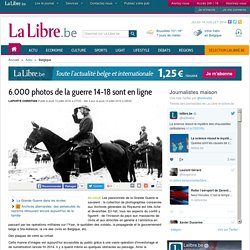
En fait, tous les aspects du conflit y figurent : de l’invasion du pays aux massacres de civils et aux atrocités en général à l’armistice en passant par les opérations militaires sur l’Yser, le quotidien des soldats, la propagande et le gouvernement belge à Ste-Adresse, la vie des civils en Belgique, etc. Des plaques de verre au virtuel Cette manne d’images est aujourd’hui accessible au public grâce à une vaste opération d’inventoriage et de numérisation lancée fin 2014. Il y a quand même eu quelques obstacles au passage. Remember the War - Remembering our heroes - 13th November 2011.
My Profile - My TES. La Fabrique du centenaire. 14 - 18, la Grande Guerre. A bientôt de vos nouvelles. L'Histoire à la carte : Le déclenchement de la Première Guerre mondiale. L'Histoire à la carte : Le déclenchement de la Première Guerre mondiale. L'Histoire à la carte : Le déclenchement de la Première Guerre mondiale. Portail officiel du centenaire de la Première Guerre mondiale. Le début des tranchées. A bientôt de vos nouvelles. Charles upham. Tehran Conference. Prelude[edit] As soon as the German-Soviet war broke out, Churchill offered assistance to the Soviets and an agreement to this effect was signed on 12 July 1941.[2] Delegations had traveled between London and Moscow to arrange the implementation of this support and when the United States joined the war, the delegations included Washington in their meeting venues.

A Combined Chiefs of Staff committee was created to coordinate British and American operations as well as their support to the Soviet Union. Stalin obsessively wished to control everything in Moscow and was unwilling to risk journeys by air,[3] while Roosevelt was physically disabled and found travel grueling. Churchill was an avid traveler and had met with Roosevelt on two previous occasions in the United States and had also held two prior meetings with Stalin in Moscow.[2] In order to engineer this urgently needed meeting, Roosevelt tried to persuade Stalin to travel to Cairo.
Proceedings of the Conference[edit] See also[edit] Why was the treaty of Versailles so significant? - Rise of Hitler and the Nazi party - Year 9 - SchoolHistory.co.uk. Why was the Treaty of Versailles so significant?

The Treaty of Versailles was put together at the Paris Peace Conference starting in January 1919. The main signatories of the treaty were Britain (Prime Minister David Lloyd George), the USA (President Woodrow Wilson), France (Prime Minister Georges Clemenceau) and Italy (Prime Minister Vittorio Orlando). These leaders were known as the 'Big Four' and met to decide the fate of Germany after the First World War. So why is this treaty so significant? To answer this question, it is important to consider a number of issues. History - World War Two: Summary Outline of Key Events.
Comprendre le débarquement des Alliés en Normandie le 6 juin 1944 -... Winston Churchill. 1939: On ira pendre notre linge sur la ligne Siegfried. Robert Ménard donne une leçon aux professeurs d'histoire. Pour les articles homonymes, voir SOE.

Articles détaillés : SOE en Abyssinie, SOE en Albanie, SOE en Allemagne, SOE en Belgique, SOE au Danemark, SOE en France, SOE en Grèce, SOE en Italie, SOE en Norvège, SOE aux Pays-Bas, SOE en Pologne, SOE en Roumanie, SOE en Yougoslavie et Force 136. Présent dans les pays de l'Axe Rome-Berlin-Tōkyō, le SOE déploie également des sections dans les pays neutres (Espagne, Syrie, etc.)[1]. La place du SOE dans l'histoire de la Résistance est complexe et donne lieu à certaines confusions : rattaché au Ministère de la Guerre économique, le SOE ne dépend pas du Ministère de la guerre (War Office, WO), pas davantage que des autres services secrets britanniques, tels que le fameux Intelligence Service[a]. The British Soldier Who Killed Nazis with a Sword and a Longbow. "Mad Jack" on the far right, clutching a claymore sword.
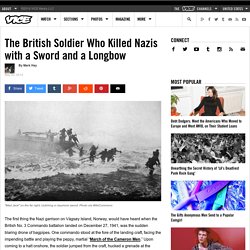
Photo via WikiCommons The first thing the Nazi garrison on Vågsøy Island, Norway, would have heard when the British No. 3 Commando battalion landed on December 27, 1941, was the sudden blaring drone of bagpipes. One commando stood at the fore of the landing craft, facing the impending battle and playing the peppy, martial “March of the Cameron Men.”
Upon coming to a halt onshore, the soldier jumped from the craft, hucked a grenade at the Germans, then drew a full sword and ran screaming into the fray. That maniacally fierce soldier was 35-year-old Lieutenant Colonel John Malcolm Thorpe Fleming Churchill, and his stunts at this battle, known as Operation Archery, were hardly the most bizarre and semi-suicidal of his life. For many war junkies and badass aficionados, Mad Jack’s exploits are the epitome of military romanticism. Gallipoli Campaign. Gallipoli Landings 25 April 1915 General Sir Ian Hamilton's invasion plan of 25 April was to land his infantry at strategic points along the Aegean coast of the Gallipoli peninsula.
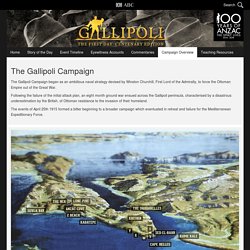
These units would then cross to the western side and take the Ottoman forts at Kilitbahir, thereby disabling their heavy guns and allowing the navy to pass unhindered through the narrows of the Dardanelles. The British 29th Division would land across 5 beaches named S, V, W, X and Y at Cape Helles, on the southernmost tip of the peninsula. They would then advance as one force, first taking the high ground of Achi Baba and the nearby village of Krithia, before crossing to capture the forts defending the narrows. Régime de Vichy. Un article de Wikipédia, l'encyclopédie libre.
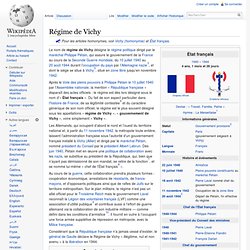
Marie Claude Vaillant Couturier. La guerre de 14-18. Le pont - film complet francais (2008) Les grandes phases de la Seconde Guerre mondiale (1939-1945) by Christine Fiasson on Prezi. World War II in Color: American Bombers and Their Crews, 1942. Within weeks of the December 1941 attack on Pearl Harbor and America’s official entry into the Second World War, Allied forces in Europe activated the now-legendary VIII Bomber Command (often referred to as the Eighth Air Force ) to serve as the principal American force to attack Germany from the air.
Often in tandem with planes from the Royal Air Force, American B-24s and B-17s — or Flying Fortresses — from the “The Mighty 8th” would spend the next several years bombing strategic towns and cities in Nazi-held Europe. As a jumping off point for countless bombing runs, including many in broad daylight, the United States Army Air Forces (the predecessor of the U.S. Air Force) set up bases in England during the war. In 1942, LIFE’s Margaret Bourke-White spent time with the Bomber Command — an assignment that LIFE shared with its readers in an October 1942 feature notable, although hardly surprising, all these years later for its triumphant tone: The Attack on Pearl Harbour Explained Infographic. Le plus jeune soldat allié mort en Normandie était un Fusilier Mont-Royal – Le Québec et les guerres mondiales.
La Seconde Guerre Mondiale - Accueil. SBS - John Rabe, The Good Nazi of Nanking (1/8) Frise chronologique seconde GM. Bataille de Stalingrad. Je déteste: Hiroshima et Nagasaki « Le dernier Québécois. Il y a parfois des gens qui me demandent: « Louis, pourquoi sembles-tu détester les États-Unis à ce point?
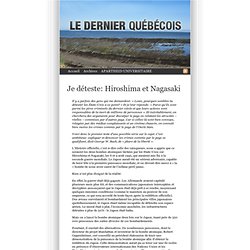
» Et je leur réponds: « Parce qu’ils sont parmi les pires criminels du dernier siècle et que leurs actions sont responsables de la mort de millions de personnes ». Et inévitablement, on cherchera des arguments pour disculper le pays en relatant les atrocités – réelles – commises par d’autres pays. Car si celles-là sont bien connues, relayées par des médias complaisants et un cinéma chauvin, on connaît bien moins les crimes commis par le pays de l’Oncle Sam. Voici donc le premier texte d’une possible série sur le sujet. 8h15 6 AOUT 1945 : Hiroshima. Retour sommaire L'atome au service de la guerre Jamais une découverte scientifique n'a été si rapidement appliquée, jamais de tels moyens financiers et humains n'ont été mis au service d'une aventure techno-scientifique.
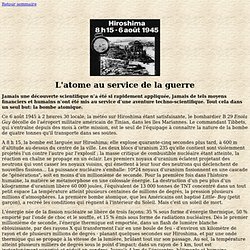
Bombardements atomiques de Hiroshima et Nagasaki. Un article de Wikipédia, l'encyclopédie libre.
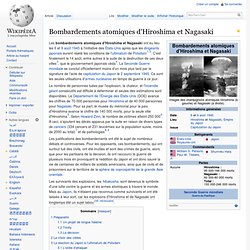
Les bombardements atomiques d'Hiroshima et Nagasaki ont eu lieu les 6 et à l'initiative des États-Unis après que les dirigeants japonais eurent rejeté les conditions de l'ultimatum de Potsdam[1],[2]. C'est finalement le 14 août, entre autres à la suite de la destruction de ces deux villes[3], que le gouvernement japonais céda[4]. La Seconde Guerre mondiale se conclut officiellement moins d'un mois plus tard par la signature de l'acte de capitulation du Japon le .
La première guerre mondiale (1914-1918) Mémorial de la Shoah. Sous-marins japonais : du renforcement « historique » de la flotte à la coopération internationale. C’est ainsi la menace chinoise qui est clairement identifiée. Firestorm Over Dresden (full) Canadian Japanese Internment Camps. Posted: May 11, 2011 in The Nikkei Kanadajin Police banging on doors at all hours of the day or night, ordering frightened occupants to gather up only what they could carry.
Parents and children innocent of any crime ushered from their homes, herded in a central depot and freighted out by train to remote camps. A scene from Nazi Germany? No, it was the internment of the Japanese in British Columbia, 1942. The evacuation of the Japanese Canadians, or Nikkei Kanadajin, from the Pacific Coast in the early months of 1942 was the greatest mass movement in the history of Canada. Auschwitz-Birkenau Virtual Tour - Auschwitz-Birkenau - Wirtualne zwiedzanie. Voyages en résistances. Le débarquement de Normandie : du D-Day à la libération de Paris. 7 décembre 1941 : Attaque japonaise de la flotte américaine du Pacifique à Pearl Harbor. L'attaque sur Pearl Harbor, base navale américaine située sur l’île d’Oahu, dans l’archipel d’Hawaï, au cœur de l'océan Pacifique, fut lancée par surprise le matin du dimanche 7 décembre 1941 par le Service aérien de la marine impériale japonaise contre la flotte américaine du Pacifique dans le port et d’autres forces qui stationnaient aux alentours.
L'album de Rachel et Hannah. L'album de Rachel et Hannah. Nagasaki. La chute du Reich [carte] Corbis: photography, rights, motion. The U.S. and Japan have very different memories of World War II. AFP/Getty Images On Tuesday, President Obama announced his decision to visit Hiroshima, Japan, the site where the U.S. dropped an atomic bomb in August 1945. Obama will specifically visit Memorial Park, which commemorates the event; he will be the first sitting American president to do so, although he does not plan to offer any sort of apology. The bombing of Hiroshima killed around 100,000 people; three days later, tens of thousands more were killed after the United States bombed Nagasaki. Isaac Chotiner is a Slate contributor. To discuss the issues of war and memory, I spoke by phone with Carol Gluck, a professor of Japanese history at Columbia University.
Isaac Chotiner: What did you make of President Obama’s decision to visit Memorial Park? Carol Gluck: I think it is a very good decision. The first reason is that the atomic bomb narrative is extremely strong in every country I have studied. Rise of the Devised. Remembering WW1 - 100 years on. The U.S. and Japan have very different memories of World War II. WW2. Rise of the 4th Reich: Nazi's Control America!
Thesis. From trench to tomb: The unknown warrior's journey. 11 November 2010Last updated at 02:12 By Mario Cacciottolo BBC News The tomb, in London's Westminster Abbey The unknown warrior was carried from a French battlefield 90 years ago, to be laid to rest among kings and statesmen in Westminster Abbey. But how did this symbol of the sacrifice of war come to be chosen? In 1916, a Church of England clergyman serving at the Western Front in World War I spotted an inscription on an anonymous war grave which gave him an idea. That moment of inspiration would blossom into a worldwide ceremony that is still being replicated in the 21st Century - the grave of an unknown warrior, symbolising those who made the ultimate sacrifice for their country.
The Reverend David Railton caught sight of the grave in a back garden at Armentieres in France in 1916, with a rough cross upon which was pencilled the words "An Unknown British Soldier". But there was a procedure in choosing a single corpse to represent the many unnamed dead. WW1 presentation. Front Populaire : la semaine de quarante heures.
Anzac Org. Hiroshima & nagasaki. Evacuation fears for 15,000 people after complete German wartime V-2 Rocket found off British coast. A six-man team of Royal Navy bomb disposal experts are working urgently to make sure the rusting weapon's one-ton warhead won’t detonate By Daily Mail Reporter Published: 18:13 GMT, 29 March 2012 | Updated: 14:56 GMT, 30 March 2012 Great-grandfather Ruben Dace warned police of the V2 missile after watching falling just off the coast of East Anglia They killed thousands in the final months of the Second World War, fired from occupied Europe at the cities and ports of the south-east. So when great-grandfather Reuben Day, 82, saw one of Hitler's terrifying V-2 rockets falling just off the coast of East Anglia he informed the police straight away.
But despite Mr Day, then a teenage fishermen, showing police the unexploded rocket lying in the mud - it remained there largely undisturbed for 68 years. Over the years the deadly missile has only been approached by the occasional sailor using the 2ft of metal which protruded from the mudflats at low tide to moor their boats. Enlarge.